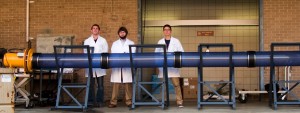Blast induced traumatic brain injury (bTBI) was the signature injury of the wars in Iraq and Afghanistan. It has been estimated that as many as 20% of veterans of those wars suffer from some form of bTBI. There is disagreement about what, precisely, the cause of the bTBI injury is, but generally we consider four types of injury caused by blast:
- Primary blast injury (injury caused by the shock wave interacting with the body)
- Secondary blast injury (injury caused by objects accelerated into the body, like shrapnel)
- Tertiary blast injury (injury caused by the acceleration of the body into objects)
- Quaternary blast injury (injury caused by the heat of the blast, radiation, chemical exposure, or other miscellaneous injury)
Primary blast injury is of interest since it is mechanistically different from the other injuries. Primary bTBI could be caused by direct interaction of the blast wave with the brain, or potentially through abdominal transmission of the blast wave to the brain. There has even been suggestions that bTBI is caused by systemic effects of blast rather than the local effects of the blast wave on the brain.
The focus of our research is to:
- Understand the mechanism of injury
- Develop preventative measures
- Develop treatments
Friedlander Waveform
The Friedlander Waveform is the idealized format of a blast wave caused by high explosives.
Specifically we have several research areas:
Shock Tube Design
Our research involves using a shock tube to simulate blast conditions and replicate mild to moderate blast injury. The unique design is:
- Portable
- Polymer based and MRI compatible
- Rapidly resettable
Blood Brain Barrier Damage as a Mechanism of Injury
In collaboration with Dr. Ashock Shetty from the Center for Regenerative Medicine at the Texas A&M Health Science Center in Temple TX, we have gathered preliminary data about how injury occurs in bTBI using a mouse model of bTBI.
Elastography Imaging in bTBI
We are interested in using MRI elastography as a research tool in diagnosing, tracking, and studying bTBI



